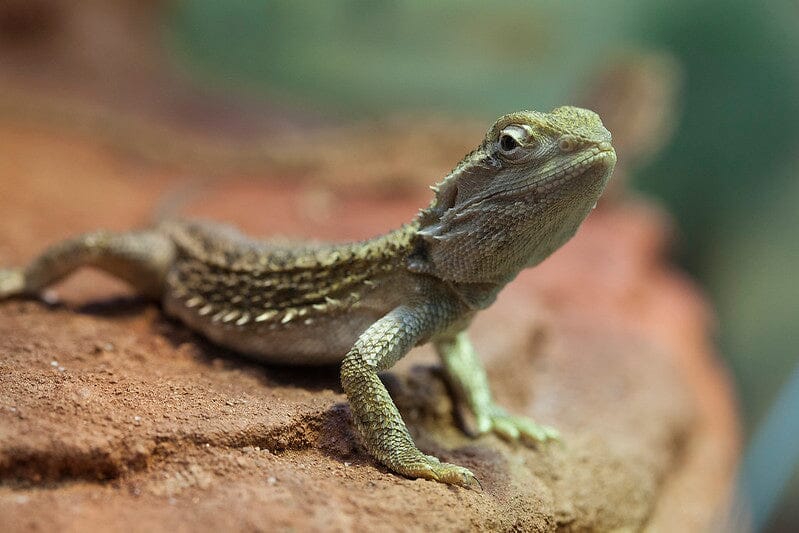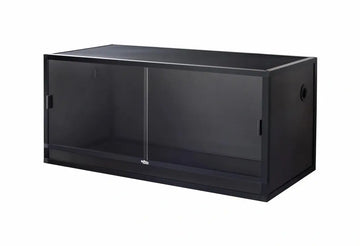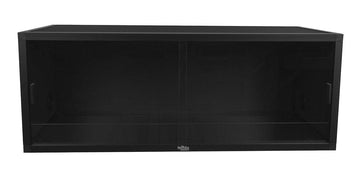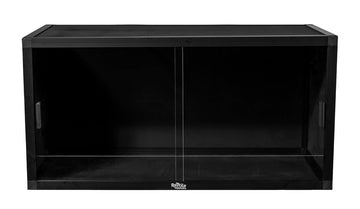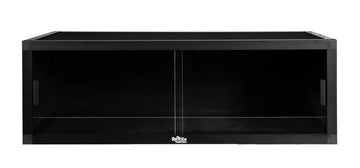Rankins dragons (Pogona henrylawsoni) are 12” long, diurnal, terrestrial lizards native to central Queensland, Australia. They prefer the area’s black soil plains for habitat, characterized by a dry climate with cracked clay substrate and extremely sparse vegetation. Rankins dragons are known by a variety of alternative common names, including blacksoil bearded dragon, dumpy dragon, Downs bearded dragon, Lawson’s dragon, pygmy bearded dragon, or dwarf bearded dragon.
Rankins dragons generally look like a juvenile central bearded dragon with a few differences. Their head is large and more rounded, little to no “beard,” short spikes interspersed with the back scales, a relatively short tail, and short spikes at the base of the tail. Coloration is tan to grayish, with a pale belly, pale blotches on either side of the spine, and a ringed pattern on the tail. Some adults are essentially patternless.
Rankins dragons are generally considered to be a good alternative to bearded dragons for people who are interested in a pet bearded dragon but don’t have enough space to house one adequately.
Minimum terrarium size for Rankins dragons
The absolute minimum enclosure size for a single Rankins dragon is 36”L x 18”W x 18”H, or a 40 gallon breeder-style tank. However, if you can provide larger, your pet will absolutely use the extra space!
It is possible to successfully house multiple Rankins dragons together in a 48”x24”x24” enclosure or larger. For best results, do not house multiple males in the same enclosure, but one male and multiple females can work, or simply a group of females. However, cohabitation is optional. Your lizard will be just fine having the terrarium all to itself!
Do Rankins dragons need UVB?
Yes! Rankins dragons require UVB lighting for their survival. UVB lighting helps provide a clear day/night cycle, provides all of the vitamin D that your pet needs, strengthens the immune system, facilitates better digestion, and other benefits.
The best UVB bulbs for a Rankins dragons housed in a 18-24” tall enclosure are:
- Zoo Med Reptisun T5 HO 10.0
- Arcadia Desert 12%
For best results, house the UVB bulbs in a highly reflective fixture by Arcadia or Vivarium Electronics. Position the lamp on the same side of the terrarium as the heat lamp. If the UVB is mounted over screen, place the basking surface 9-12” below the lamp. If the UVB is mounted inside the enclosure, place the basking surface 14-16” below the lamp.
They are also likely to benefit from plant grow lights as part of their environment as well. Add a ~6500K LED or T5 HO fluorescent grow lamp to provide extra illumination, as well as help any live plants in the enclosure to thrive.
Lights should be on for 11 hours/day during winter and 13 hours/day during summer to simulate seasonal changes in day length. All lamps should be turned off at night.
Best temperature for Rankins dragons
Rankins dragons need a basking temperature between 100°F, and 75-85°F on the cool side. Temperatures should be measured via infrared thermometer. For best results, use a flat piece of stone or wood as the basking surface.
Provide heat for your lizard with a halogen flood heat bulb placed above the basking branch. Halogen bulbs are the best way to imitate the warmth of sunlight indoors, and considered to be a superior form of reptile heating by experts. Do not use ceramic heat emitters (CHEs), red bulbs, or blue bulbs, as these are not as effective. Mount the bulb in a ceramic-socket dome fixture to minimize the risk of fire.
The heat lamp and all other light sources should be turned off at night to allow the enclosure to cool down. Temperatures can safely drop as low as 55°F without need for a lightless nighttime heat source.
Best humidity levels for Rankins dragons
Rankins dragons may be a semi-arid species, but that doesn’t mean you should simply ignore humidity as part of their husbandry. Provide 30-50% humidity on average, although occasional fluctuations lower or higher are safe. Keep track of humidity levels with a digital probe hygrometer placed in the middle of the terrarium.
To increase nighttime humidity levels, heavily mist the enclosure each evening with a pressure sprayer. It’s also a good idea to quickly mist the enclosure first thing each morning to create a morning-dew effect and encourage your dragon to drink.
Best substrate for Rankins dragons
Substrate (aka bedding) covers the floor of the terrarium and helps make the enclosure more attractive, but it also helps maintain healthy joints and may provide something for your lizard to dig in.
We recommend the following substrates for Rankins dragons:
- Zoo Med ReptiSand
- Zoo Med Excavator Sand
- Exo Terra Desert Sand
- Exo Terra Stone Desert
- 60/40 play sand/topsoil mix
Substrate should be at least 2” deep and completely replaced every 3-4 months. Remove poop and urates daily, along with contaminated substrate.
How to decorate a Rankins dragon terrarium
An empty enclosure makes for a bored lizard, reducing its quality of life. Keep your pet entertained and engaged with its environment with the strategic use of décor items that encourage it to exercise natural behaviors!
Since Rankins dragons are a terrestrial species, at bare minimum you will need a flat basking surface and a couple of places for them to hide. However, you will also need to include other items, such as:
- secure stacks of flagstone or aquarium slate
- vertically-oriented concrete slabs
- ledges
- branches
- drought-tolerant live or artificial plants
If you need ideas on how to decorate your pet’s enclosure in a functional way, the best thing to do is look at pictures of Rankins dragons in their natural habitat.
What to feed to a Rankins dragon
Rankins dragons are omnivorous, which means that they need to eat both plant- and animal-based foods to get the nutrition they need. The foods that they need are mostly insects and leafy greens. Here’s a basic feeding schedule:
- Hatchlings (<3 months) — bugs 2-3x/day + leafy greens daily
- Juveniles (3-7 months) — bugs 2x/day + leafy greens daily
- Subadults (7-12 months) — bugs + leafy greens daily
- Adults (>12 months) — bugs 3-5x/week + leafy greens daily
Variety is the key to providing a healthy, balanced diet for your pet. The more variety you can provide, the better!
Feeder insects for Rankins dragons: dubias, discoids, red runner roaches, crickets, black soldier fly larvae, hornworms, silkworms, mealworms
Leafy greens for Rankins dragons: alfalfa, arugula/rocket, bok choy, brussels sprouts, cactus pads, carrot greens, cress, collard greens, dandelion greens, endive, kale, mustard greens, radicchio, red leaf lettuce, romaine lettuce, spinach, turnip greens
Supplements
You will also need calcium and vitamin supplements to prevent your lizard from developing a deficiency. Repashy Calcium Plus LoD, lightly dusted on all insects. It’s okay to occasionally skip a dusting. Supplement powder should not be put on salads.
Drinking Water
You will also need a water bowl to help keep your pet hydrated. Keep the water clean and scrub the bowl with a reptile-safe disinfectant weekly, or whenever it becomes soiled.
How to handle your Rankins dragon
Reptiles generally don’t appreciate petting and handling in the same way that dogs and cats do. That being said, Rankins dragons tend to tolerate human interaction very well. Here are some tips for success:
- Don’t grab the lizard from above. Instead, scoop from below.
- Support as much of its body as possible, especially the feet.
- Start with short handling sessions at first, then gradually make them longer.
- Put the lizard back in its enclosure only when it’s calm.
You will have to work to gain your pet’s trust, so be especially careful to create a positive association with yourself in their mind. It’s best to encourage the dragon to come out of the enclosure and climb onto you on their own, rather than simply grabbing them whenever you’re in the mood for handling. Never grab a reptile out from its hiding place, as this is a very effective way to make it feel unsafe.
Treats and hand-feeding are very effective for teaching your pet that you are not something to be feared. Use soft-tipped feeding tongs to prevent getting bitten by accident.
*This care sheet contains only very basic information. Although it’s a good introduction, please further your research with high-quality sources. The more you know, the better you will be able to care for your pet!
"Lawson's Bearded Dragon" by PacificKlaus is licensed under CC BY-NC 2.0.

